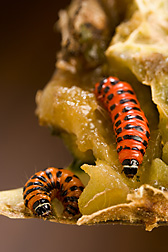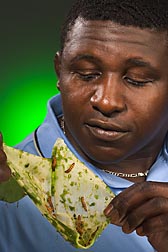This page has been archived and is being provided for reference purposes only. The page is no longer being updated, and therefore, links on the page may be invalid.
Read the magazine story to find out more. |
|
Protecting the Prickly Pear Cactus in Its Native Habitat
By Sharon DurhamSeptember 1, 2006
Scientists with the Agricultural Research Service (ARS) in Georgia and Florida are working to control a moth that is threatening an important cactus that is native to the southern United States and Mexico.
Ironically, the South American cactus moth was used to control the spread of the same cactus species in Australia in the 1800s. The prickly pear cactus, as the species is called, is not native to Australia but was an invasive pest in that country.
Then, in 1957, the moth was introduced to the island of Nevis in the West Indies, by government request, to control the same cactus, which was also an invasive species on that Caribbean island. Eventually, the cactus moth spread to surrounding islands, landing in the Florida Keys in 1989. Since then, the moth has moved along both Atlantic and Gulf coasts and now threatens the prickly pear cactus in its native habitat in the southern United States and Mexico, where it is grown as a specialty food crop.
Entomologist James Carpenter, in the ARS Crop Protection and Management Research Unit at Tifton, Ga., has been studying the use of the sterile insect technique (SIT) to control the cactus moth in the United States. Carpenter and cooperators are mass-rearing the moth on an artificial diet, irradiating male moths to induce sterility and then releasing the males to mate with wild female moths. Using this approach, the resulting offspring are infertile, thus reducing the target insect population.
Carpenter is working with entomologist Stephen Hight at the ARS Center for Medical, Agricultural and Veterinary Entomology in Gainesville, Fla., colleagues at other U.S. Department of Agriculture agencies, and researchers at Florida A&M University.
The SIT trial evaluation involves three sites: Dauphin Island, Ala.; Okaloosa Island, Fla.; and St. George Island, Fla. Dauphin Island is receiving sterile insects and undergoing a sanitation procedure. Okaloosa Island is only being sanitized, and St. George Island is being left unchanged.
Sanitation involves the removal of cactus pads infested with moth larvae and pupae, and removal of egg sticks. The combination of SIT and sanitation has been very successful in reducing the cactus moth population on Dauphin Island to near non-detectable levels.
Read more about the research in the September 2006 issue of Agricultural Research magazine.
ARS is the USDA’s principal scientific research agency.


